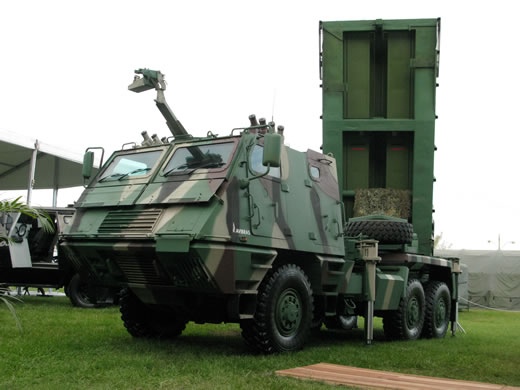AVIBRAS, established in 1961 as an independent aerospace company in Brazil shifted its focus in the 1970s to the development of artillery rockets. At LAAD Avibras displayed their latest member of the ASTROS 2 Mk 5 multiple launch rocket system, the AV-SS-80 300 mm rocket, fully compatible with the ASTROS II system, this 300mm rocket can hit targets up to 85 km afar. The SS80 rocket has already been sold to several international customers, including Saudi Arabia and other Gulf states. ASTROS II was originally developed in the late 1970s as an area saturation weapon, with the first customer being Iraq, utilizing the system in the later phase of its war against Iran in the 1980s. The rocket was used by both sides in the First Gulf War in 1991, as it was used by Iraq and Saudi Arabian armies.

Since then the Brazilian Army has also adopted the system, fielding the SS-30 127mm, SS-40 180 mm rockets and SS-09 TS 70 mm subcaliber training rounds. The Brazilian military has also renewed its interest in Avibras guided-rocket program, a 450mm ‘cruise missile’ version of the rocket (the ASTROS II will be able to carry two such missiles with the current system’s current launchers). The tactical missile (ASTROS II TM) will have a range of 300 km and carry a warhead weighing about 250 kg. It will employ INS/GPS guidance and will follow a pre-programmed route. The missile shown on display shows different features that, according to AVIBRAS officials have not been concluded yet. For example, the missile uses a rocket and turbo-jet propulsion – the final version will have either boost-sustain rocket-turbojet combination of a rocket propulsion sustaining the missile through its flight. The missile will have an auto-pilot system controlling two flight surfaces for cruise phase. The basic missile will offer typical INS;GPS precision level which could be further improved by adding a terminal guidance seeker.
AVIBRAS is also working on the development of trajectory correction system improving the precision of its long-range rockets, although, according to company officials, there will always be a need for the original area saturation capability offered with the ‘free flight’ version.
At LAAD 2011 the Brazilian defense company Avibras Is showing its new unmanned aerial vehicle called Falcao. The UAV is currently in advanced development and the first flight test is scheduled for later in 2011. This UAV has is designed for a gross takeoff weight of 650 kg, carrying 150 kg of payload over a range of 2500 km flying at 15,000 ft altitude. Falcao is designed for a wide range of applications. It was developed by the Aerospace Technology Development authority FINEP, under a Brazilian Air Force program, with AVIBRAS being a leading partner. Falcao can be used in support of many military and homeland security applications, including supporting other AVIBRAS weapon systems.
















